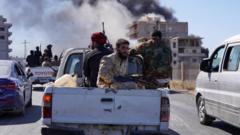Following U.S. strikes on Iran's Fordo nuclear enrichment site, satellite imagery shows extensive activity aimed at assessing damage rather than initiating repairs, indicating a careful investigative approach by Iran.**
Iran's Fordo Nuclear Site: Post-Attack Activity Highlighted in Satellite Imagery**

Iran's Fordo Nuclear Site: Post-Attack Activity Highlighted in Satellite Imagery**
Recent satellite images reveal significant activity at Iran's Fordo nuclear facility following U.S. airstrikes, raising questions about damage assessments and future actions.**
Satellite images captured shortly after the U.S. strikes on Iran’s Fordo nuclear enrichment facility reveal intense activity, with various construction efforts visible at the heavily fortified site. These images, recorded by Maxar Technologies, display new roads created leading to the strike sites, and machinery such as cranes and excavators being used for assessment, suggesting Iran is beginning to evaluate the extent of the damage.
Joseph S. Bermudez, a senior fellow specializing in imagery analysis at the Center for Strategic and International Studies, commented on the images, saying, “It appears that they’re evaluating the hole, evaluating how deep it went.” This assessment aligns with reports of 12 Massive Ordnance Penetrators, known as "bunker busters," being deployed by American B-2 bombers during the strikes on June 22. President Trump described the impact as having “obliterated” the facility, though other analysts take a more measured view.
Experts believe Iran is primarily focused on analyzing the consequences of the attacks instead of pursuing immediate repairs or reconstruction. Peter McDonald, a director at Viper Applied Science, noted, “It looks to me like they’re examining the impact of the event rather than doing any thing more substantial like carrying out repairs or recovery.” Additionally, a day following the U.S. engagements, Israel also claimed it had struck the Fordo site, targeting access routes.
Subsequent satellite imagery from June 27 illustrates that Iran took swift action to fill in a significant crater caused by earlier Israeli strikes, indicating a rapid response to restore access. However, experts assert that no signs of reactivation or substantial repair efforts are currently evident. “I don’t think they’ve moved into the phase of reactivation,” remarked Bermudez, noting that the current evidence suggests Iran remains in a damage assessment stage instead of initiating repairs.
In conclusion, the insights drawn from the satellite images highlight a complex situation at Iran's Fordo facility, with active evaluations occurring in the aftermath of the significant military strikes, setting the stage for future developments in this ongoing geopolitical tension.





















